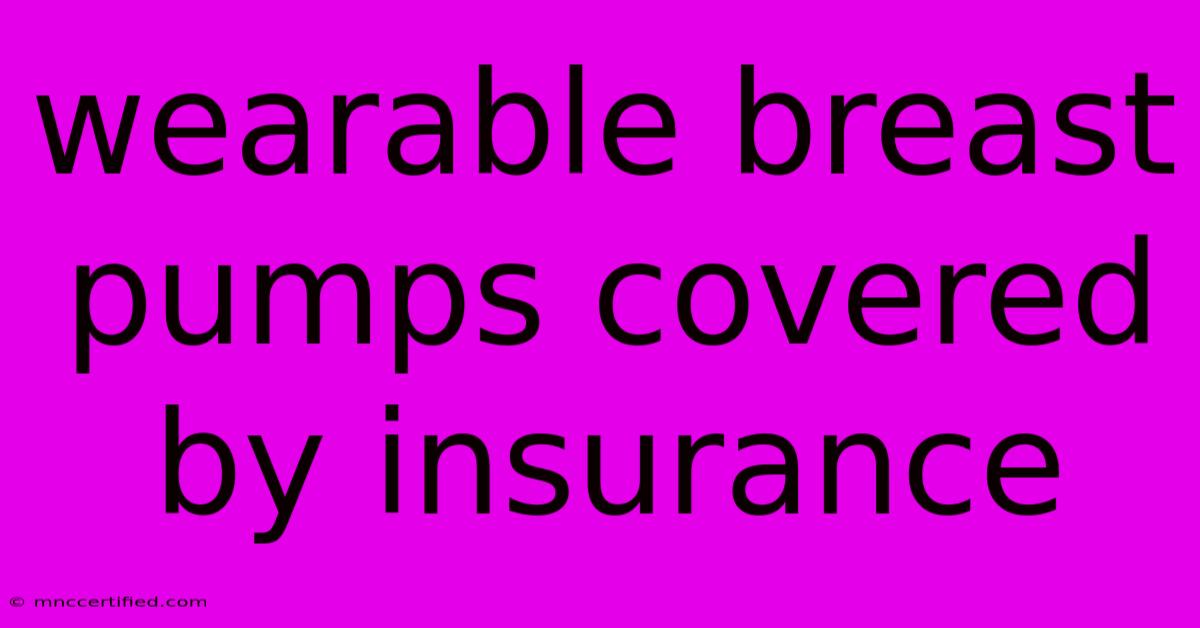Wearable Breast Pumps Covered By Insurance

Table of Contents
Pumping on the Go: Are Wearable Breast Pumps Covered by Insurance?
For working moms, pumping on the go can be a game changer. But with the cost of breast pumps, it's natural to wonder about insurance coverage. Wearable breast pumps offer a unique solution, but navigating insurance coverage can be tricky. In this article, we'll explore the ins and outs of insurance coverage for wearable breast pumps and provide tips to maximize your chances of approval.
Understanding Your Insurance Coverage
The Affordable Care Act (ACA) mandates that most health insurance plans cover breast pumps, including manual, electric, and hospital-grade pumps. However, coverage specifics vary by insurance provider and plan. Here's what you need to know:
- Coverage for Wearable Pumps: While the ACA doesn't explicitly mention wearable pumps, many insurance companies recognize them as a type of breast pump and offer coverage.
- Pre-Authorization: You'll likely need to get pre-authorization from your insurance company before purchasing a wearable pump. This involves submitting a prescription from your doctor and providing details about your specific needs.
- Limitations: Some insurance plans may have limits on the number of pumps covered or the total cost they will pay.
Navigating the Pre-Authorization Process
Here's a step-by-step guide to help you navigate the pre-authorization process for your wearable breast pump:
- Talk to your doctor: Explain your need for a wearable pump and request a prescription. Be prepared to share information about your pumping frequency, duration, and desired features.
- Contact your insurance provider: Get information about your plan's coverage for breast pumps. Ask about specific requirements for wearable pumps, including documentation, pre-authorization forms, and any coverage limitations.
- Submit the necessary paperwork: Provide your insurance company with the required documents, including your prescription and pre-authorization form. Be sure to double-check all details for accuracy.
- Follow up: Keep track of your pre-authorization request and follow up with your insurance company if you haven't received a decision within a reasonable time.
Tips for Increasing Your Chances of Coverage
- Be proactive: Start the pre-authorization process early, ideally before you even need the pump. This gives you time to address any issues or delays.
- Choose the right pump: Select a wearable pump that is compatible with your insurance plan. Research different brands and models and consult with your doctor or a lactation consultant.
- Provide detailed documentation: Include any medical documentation supporting your need for a wearable pump, such as a diagnosis of a medical condition that makes traditional pumping difficult.
- Be persistent: If your initial request is denied, don't give up. Appeal the decision and be prepared to provide additional information to support your case.
Conclusion: Pumping Freedom with Insurance Coverage
While navigating insurance coverage for wearable breast pumps can be challenging, it's not impossible. By understanding your plan's specifics, being proactive in the pre-authorization process, and advocating for your needs, you can increase your chances of getting coverage for this valuable tool for pumping on the go. Remember, your health insurance company is there to help you access the care you need. Don't hesitate to reach out with questions or concerns to ensure you're getting the most out of your benefits.

Thank you for visiting our website wich cover about Wearable Breast Pumps Covered By Insurance. We hope the information provided has been useful to you. Feel free to contact us if you have any questions or need further assistance. See you next time and dont miss to bookmark.
Featured Posts
-
Gallery Odegaard Back In Arsenal Training
Nov 07, 2024
-
Loan Insurance Organization Crossword Clue
Nov 07, 2024
-
Trumps Shadow Bidens Terms Impact
Nov 07, 2024
-
What Does Plpd Insurance Cover In Michigan
Nov 07, 2024
-
Investment Banks In San Francisco Bay Area
Nov 07, 2024